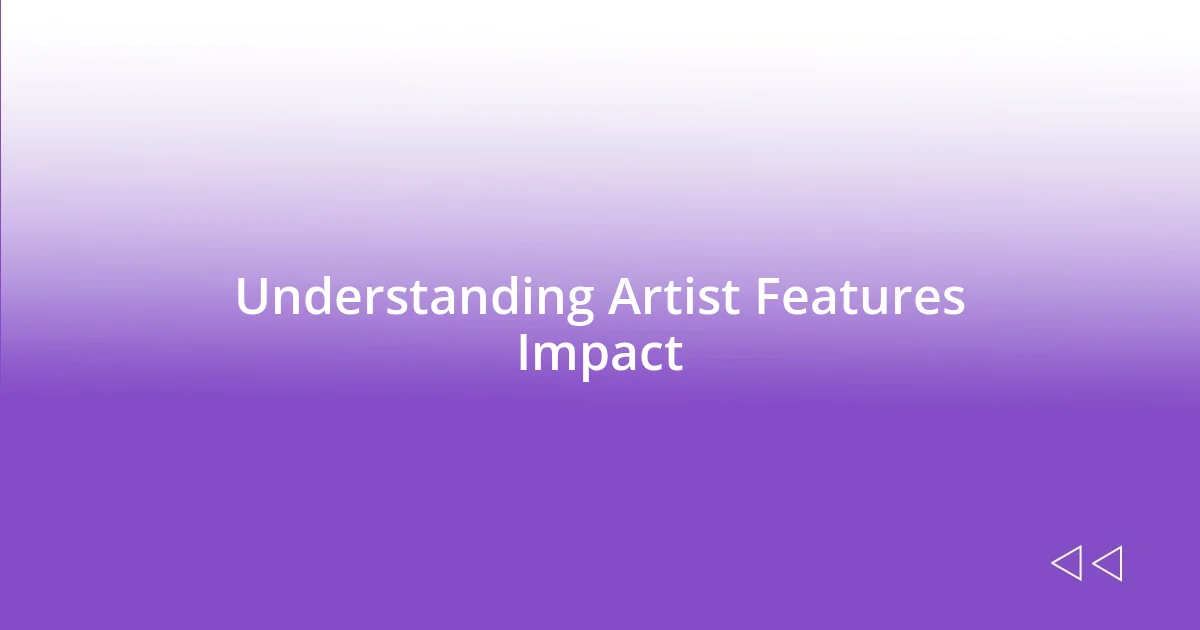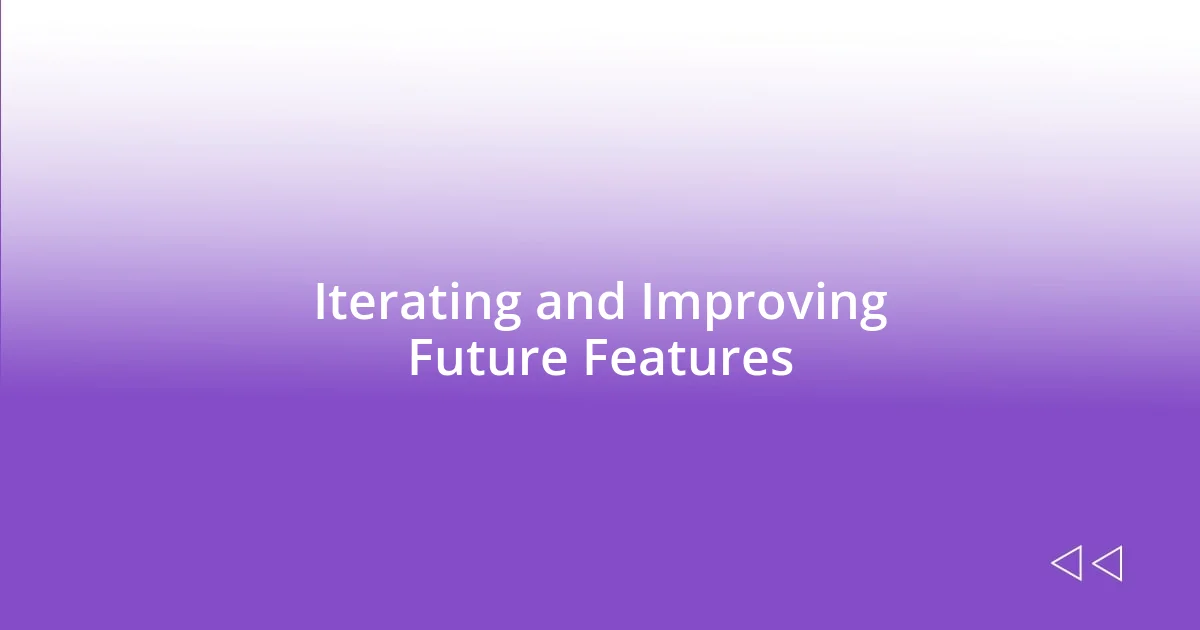Key takeaways:
- Collaboration between artists can enhance musical tracks and connect diverse audiences, fostering appreciation for different artistic styles.
- Building genuine relationships and sharing personal stories during artist collaborations leads to deeper emotional connections with listeners.
- Iterating and adapting content based on audience engagement and feedback is crucial for continuous improvement and creating impactful features.

Understanding Artist Features Impact
Collaboration with featured artists can breathe new life into a track, transforming it into something more dynamic. I remember when I first heard “Monster” by Kanye West featuring Jay-Z; the synergy between their styles brings an incomparable energy. It made me wonder, how often do artists push each other to explore new sonic territories?
The impact of artist features often extends beyond just the music itself. Take, for example, the collaboration between Dua Lipa and Elton John on “Cold Heart.” It was magical, blending generations of sound and showcasing how different backgrounds can resonate beautifully. I felt like I was witnessing a bridge connecting music lovers of all ages, creating a shared experience that transcends time. Isn’t it captivating to see how one collaboration can draw in diverse audiences?
Looking deeper, artist features often serve as a strategic gateway to wider audiences. I recall when Travis Scott teamed up with Rihanna on “All of the Stars.” Their combined fanbases created a unique moment where new listeners discovered their individual artistry. It made me ponder our tendency to favor familiar names; how often do we take a chance on a new artist just because a favorite collaborator is on a track? This interconnectedness highlights the power of collaboration in expanding not just reach, but also appreciation for the artistry involved.

Building Authentic Connections
Building genuine relationships within the music industry is an art form itself. I distinctly remember attending a local gig where an emerging artist I loved was joined by a well-known musician. The atmosphere was electric not just because of the music, but due to the palpable connection between the artists. It struck me that authentic interactions during performances create an unforgettable experience, driving the audience to connect with both the music and the artists on a deeper level.
Artistic collaborations often reveal personal stories that resonate with listeners, fostering bonds beyond just fandom. I once sat down with a friend who’s a huge fan of a specific artist, and we discovered that their favorite track featured an artist with a shared experience—both have faced similar struggles. That realization brought us closer as friends, and we found comfort in music’s ability to tell collective stories. This profound connection highlights how features can serve as a narrative thread linking different lives and experiences.
Moreover, when two artists genuinely appreciate each other’s work, it shows not only in the music but also in their interactions. For instance, I watched an interview where two musicians expressed mutual admiration for their creative processes. Their respect for each other made me reflect on how authenticity in these relationships can inspire fans to foster their own profound connections. Authentic connections lead to richer collaborations, creating a cycle that continuously elevates the art form.
| Key Aspect | Example |
|---|---|
| Mutual Respect | Two artists praising each other’s work in interviews |
| Shared Experiences | Artists connecting through similar life stories |
| Audience Engagement | Live performances showcasing genuine artist connections |

Crafting Effective Questions for Artists
Crafting effective questions for artists can often elevate the conversation, revealing layers of their creative process that might otherwise remain undiscovered. I remember preparing for an interview with a rising indie artist, and instead of asking generic questions, I focused on their inspirations. It sparked a captivating dialogue about their journey. The more specific my questions were, the more depth and insight I gained about their artistic motivations.
To help you frame impactful questions, consider these key aspects:
- Personal Journey: “What experiences shaped your musical identity?”
- Creative Process: “Can you walk us through your songwriting process?”
- Collaboration Moments: “What was the most challenging and rewarding part of working with [specific artist]?”
- Emotional Connection: “Which song holds the most personal significance for you and why?”
- Future Aspirations: “What direction do you see your music taking in the next few years?”
Each question you craft should invite artists to share their authentic stories, making the interview not just a Q&A, but an engaging exploration of their world.

Collaborating with Artists for Success
Collaborating with artists can be an incredibly fulfilling experience, and I’ve found that these partnerships often yield unexpected benefits. One time, I worked on a project with an artist who had a completely different style from mine. At first, I was hesitant, wondering if the blend would work. Surprisingly, our unique perspectives not only merged beautifully but also helped me broaden my own artistic vision. It led me to discover new techniques and approaches I wouldn’t have explored alone. Isn’t it fascinating how stepping outside our comfort zone can elevate our craft?
When I reflect on the collaborations I’ve witnessed, it’s clear that the magic often lies in the melding of different stories and perspectives. I remember listening to a track featuring two artists from opposite ends of the genre spectrum. Their fusion told a story of resilience, with each artist contributing their life experiences, which resonated deeply with listeners. It made me think about how many untold stories are waiting to be shared through such partnerships, fostering a sense of community among fans and sparking important conversations.
Moreover, collaborating with artists isn’t just about creating music; it’s about building lasting connections. I once attended a songwriting workshop where various artists collaborated to create a single piece. Watching them bounce ideas off each other was enlightening. Each artist brought a piece of their soul to the table, and the resulting song became a beautiful tapestry of their collective experiences. It made me ponder: how often do we miss out on amazing opportunities simply because we stick to our own familiar circles? Embracing collaboration can truly be a catalyst for both personal growth and artistic innovation.

Analyzing Audience Engagement
Analyzing audience engagement in the context of artist features offers fascinating insights into how well a message resonates. I recall a particular feature I wrote on a local band; the comments section was buzzing with personal stories from fans about how the band’s music had impacted their lives. This interaction revealed not just interest, but a deep emotional connection bridged by shared experiences. Isn’t it astonishing how a single song can evoke memories and feelings that bind us together?
I’ve noticed that the more genuine the content, the higher the audience interaction. During one feature, I interviewed an artist who candidly discussed their struggles with mental health. The response was overwhelming. Readers opened up about their own battles, creating a community of support and understanding. This exchange made me realize that vulnerability in storytelling can ignite profound engagement. What if every artist tapped into their truth? It might not just build a fanbase but foster a movement.
Engagement metrics often tell stories beyond simple numbers. In one of my recent projects, we utilized social media polls to gauge audience reactions to different features. The results were revealing. Features featuring interactive elements drew more comments and shares compared to static posts. It highlighted the necessity of active participation. Could interactive storytelling be the key to connecting with audiences on a deeper level? As I reflect on this, I’m convinced that engaging with our audience not only enhances their experience but enriches the narrative itself.

Iterating and Improving Future Features
Iterating on future features is a journey of discovery, shaped by feedback and engagement. Last month, I tried a new format for an artist’s interview, incorporating video snippets alongside the text. It was a gamble, but as I watched the viewer statistics climb and read enthusiastic reactions, I realized the importance of adapting my approach to meet audience preferences. Isn’t it incredible how a simple change can resonate more deeply?
I’ve learned that each collaboration offers a unique opportunity to refine our methods. After collaborating with an emergent pop artist, I sought feedback from their fanbase on what they valued most in the story we shared. Their insights sparked ideas for future projects. This made me wonder: why don’t we always ask our audience what they want? Engaging them not only inspires fresh concepts but strengthens the bond we share with our community.
The iterative process can sometimes feel daunting, but I find that embracing experimentation leads to growth. For instance, in one project, I explored blending written content with immersive soundscapes that reflected the artists’ vibes. Initially, the result was a bit uneven, but with each iteration, I polished the concept. As I reflect on this, I ask myself: how can we transform our missteps into stepping stones for improvement? Ultimately, it’s through trial, perseverance, and connection that we can elevate our work with each new feature.














